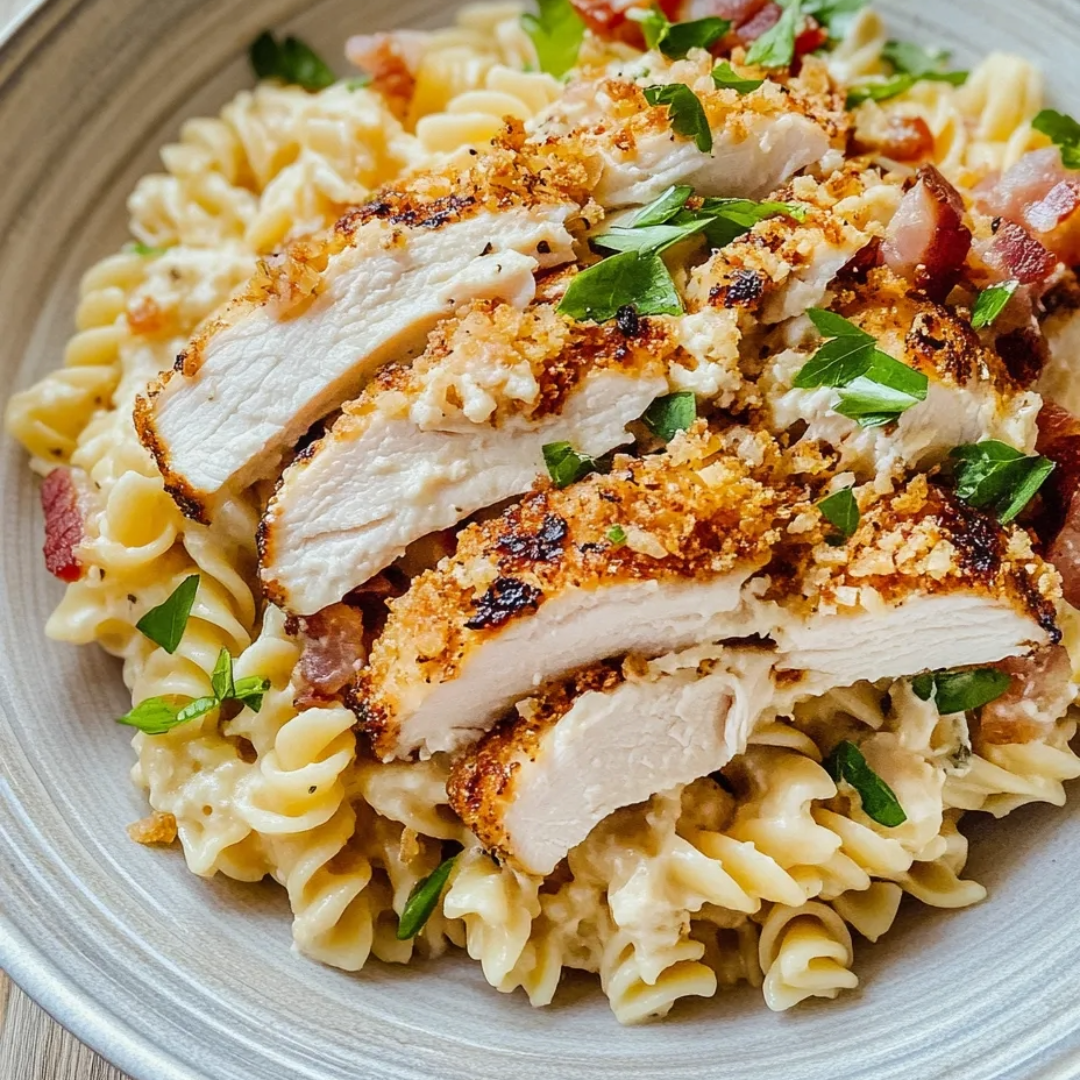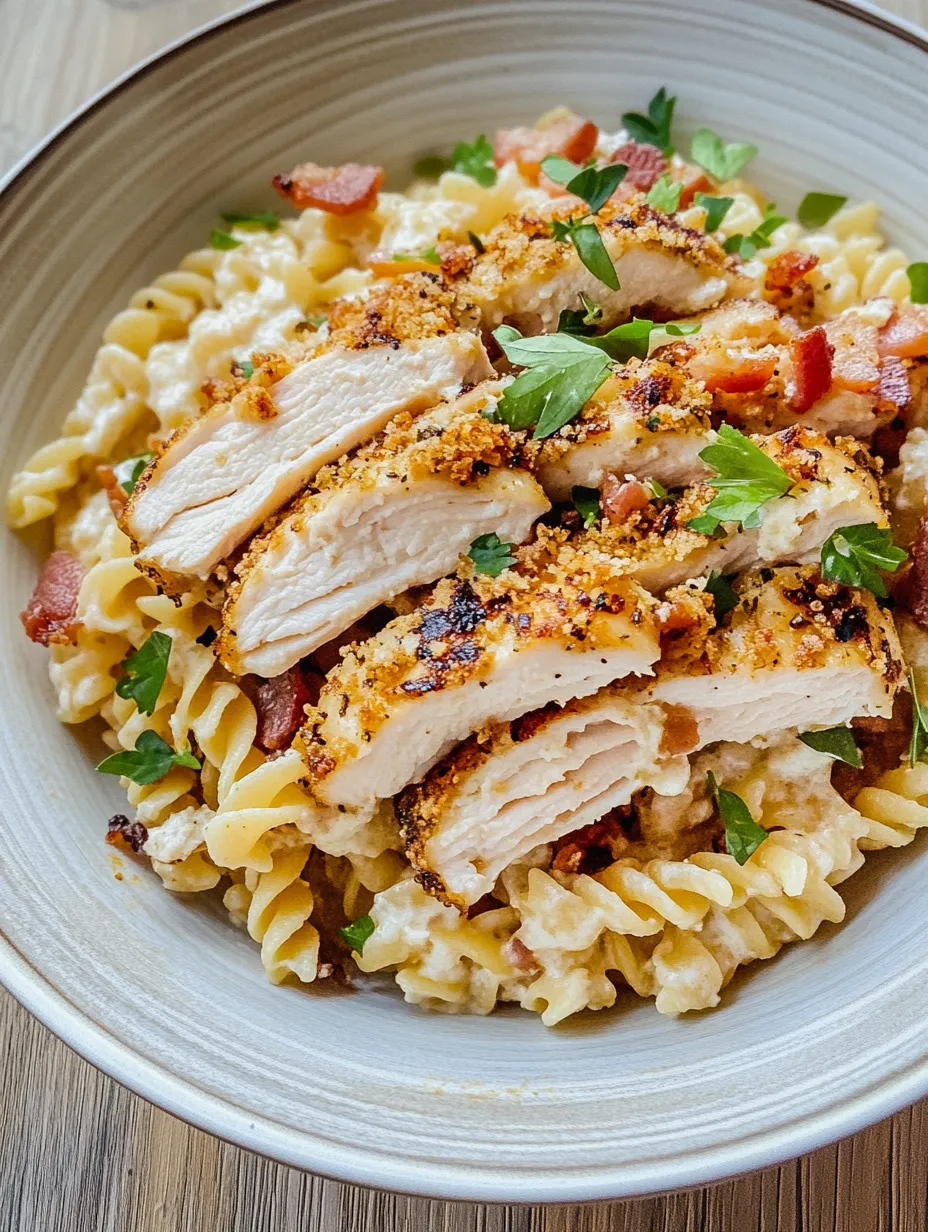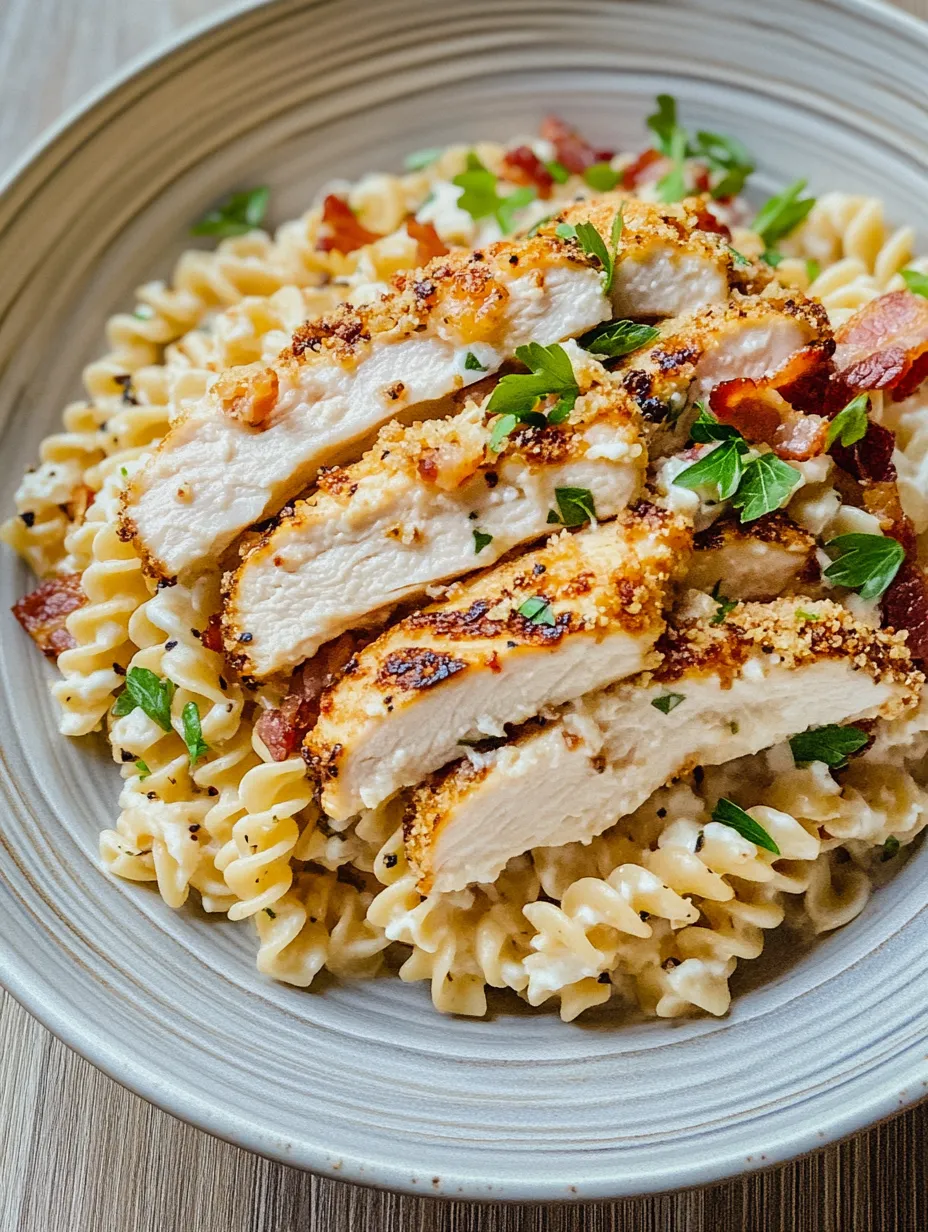 Pin it
Pin it
Creamy, protein-packed ricotta chicken pasta combines tender chicken, crispy bacon, and a velvety ricotta sauce that coats every bite with rich flavor. This 30-minute wonder transforms basic ingredients into a restaurant-worthy dish without heavy cream or complicated techniques. The sauce comes together while the pasta cooks, making this the perfect solution for busy weeknights when you want something impressive without spending hours in the kitchen.
I made this pasta last Wednesday when I was running late after my daughter's soccer practice. I had forgotten to defrost anything and was about to order takeout when I remembered I had chicken breasts in the fridge and a container of ricotta cheese. The whole family devoured it, and my son even asked if we could have it again the following night. It's now part of our regular rotation for those chaotic weeknights.
Perfect Ingredients for Ricotta Chicken Pasta
- Ricotta cheese: The star of the show that creates a silky, protein-rich sauce without the heaviness of cream; whole milk ricotta provides the best texture and mouthfeel but part-skim works well for a lighter option
- Bacon: Adds a smoky, salty crunch that elevates the entire dish; thick-cut bacon holds its texture better than thin slices
- Chicken breast: Provides lean protein that pairs perfectly with the sauce; look for uniformly sized pieces for even cooking
- Rotini pasta: The spiral shape captures the perfect amount of sauce in each bite; the structure holds up well without becoming soggy
- Fresh Parmesan: Creates depth of flavor and helps thicken the sauce; always grate it yourself rather than using pre-grated for the smoothest sauce possible
- Fresh herbs: Brighten the rich sauce with their aromatic flavors; basil offers a classic Italian note while thyme brings a subtle earthiness
- Garlic: Forms the aromatic foundation of the sauce; fresh cloves provide much more flavor than pre-minced versions
 Pin it
Pin it
I've learned through trial and error that saving extra pasta water is crucial for this recipe. The starchy water helps create a silky sauce that clings to the pasta instead of pooling at the bottom of your bowl.
Step-by-Step Cooking Instructions
- Step 1:
- Heat a large skillet over medium heat and add bacon pieces. Cook until they reach your desired level of crispness, about 5-7 minutes, stirring occasionally. Use a slotted spoon to transfer the bacon to a paper towel-lined plate, leaving the flavorful bacon fat in the pan. This fat will be the foundation for cooking your chicken, adding depth of flavor throughout the dish.
- Step 2:
- Before adding chicken to the pan, pound the breasts to an even 1-inch thickness to ensure they cook evenly. Season generously with salt and pepper on both sides. Cook in the bacon fat over medium-high heat for about 6-7 minutes per side until golden brown on the outside and reaching 165°F internally. Remove from the pan and let rest for at least 5 minutes before slicing to keep the juices inside.
- Step 3:
- While the chicken cooks, bring a large pot of water to a rolling boil. Add a generous handful of salt (the water should taste like the sea) before adding your pasta. Cook the rotini for 1-2 minutes less than the package directions to ensure it's slightly underdone. It will continue cooking in the sauce later. IMPORTANT: Before draining, scoop out at least 2 cups of the starchy pasta water – this is the secret to creating your silky sauce.
- Step 4:
- In a large bowl or measuring cup, whisk together 1 cup of the hot pasta water with 1 cup ricotta cheese and ½ cup freshly grated Parmesan until smooth. The hot water helps melt the cheese and create a uniform sauce base. Add freshly chopped herbs (about 2 tablespoons total) and freshly ground black pepper to taste. For an ultra-smooth sauce, you can blend this mixture with an immersion blender for 30 seconds.
- Step 5:
- Return the same pan used for chicken to medium-low heat. Add 2-3 cloves of minced garlic and stir constantly for about 30 seconds until fragrant but not browned. Immediately pour in the ricotta mixture and stir, scraping the bottom of the pan with a wooden spoon to incorporate all the flavorful brown bits from the chicken. These bits are culinary gold – they add incredible depth to your sauce.
- Step 6:
- Add the drained pasta directly to the sauce in the pan and toss gently but thoroughly to coat each piece. If the sauce seems too thick, gradually add more of the reserved pasta water until you reach your desired consistency. The sauce should cling to the pasta rather than pool at the bottom. Add about three-quarters of the bacon pieces and toss again.
- Step 7:
- Slice the rested chicken against the grain into thin strips or bite-sized pieces. Either fold gently into the pasta or arrange on top when serving for a more elegant presentation. Taste the pasta and adjust seasonings as needed – a final pinch of salt or squeeze of lemon juice can brighten all the flavors.
- Step 8:
- Divide pasta among warmed bowls, ensuring each portion has plenty of chicken. Top with remaining bacon pieces, additional freshly grated Parmesan, and a sprinkle of fresh herbs. Serve immediately while the sauce is still creamy and the pasta perfectly al dente.
The Magic of Ricotta Cheese
The humble container of ricotta in your refrigerator is the secret to this dish's creamy texture without the heaviness of traditional cream sauces. Unlike mascarpone or heavy cream, ricotta maintains its structure when heated, creating little pockets of creaminess throughout the dish rather than just coating the pasta.
I first discovered the magic of ricotta in pasta sauce when trying to make a lighter version of my grandmother's fettuccine alfredo. The resulting dish was so satisfying that my family didn't even notice the missing heavy cream. The ricotta adds protein while reducing the overall fat content, making this a more balanced meal than traditional cream-based pasta dishes.
Perfectly Balanced Flavors
What makes this dish special is the balance of flavors and textures in every bite. The saltiness from the bacon and Parmesan complements the mild creaminess of the ricotta. The al dente pasta provides the perfect vehicle for the sauce, while the tender chicken adds substance and protein. The fresh herbs cut through the richness, bringing brightness to each forkful.
When making this dish, resist the urge to add too many competing flavors. The beauty lies in its relative simplicity, allowing each ingredient to shine. If you want to add vegetables, stick to ones that complement rather than compete – spinach, peas, or roasted cherry tomatoes fold in beautifully.
My husband claimed he didn't like ricotta cheese until I served him this pasta. He'd only experienced it in lasagna and thought the texture was strange. After his first bite of this dish, he couldn't believe the creamy sauce was made with ricotta! Now he requests it regularly, especially when we have friends over for casual dinners.
 Pin it
Pin it
The first time I made this recipe, I was trying to recreate a dish I had at a small Italian restaurant on vacation. After several attempts, this version actually surpassed the original in our family's opinion. There's something deeply satisfying about creating a dish that looks and tastes like it came from a restaurant kitchen, especially when it takes less than 30 minutes and uses ingredients I already have on hand. On hectic weeknights when I'm tempted to order takeout, I remind myself how quickly this comes together – and how much everyone at the table appreciates a home-cooked meal that feels special, even on an ordinary Wednesday.
Frequently Asked Questions
- → Can I use whole milk ricotta instead of part-skim?
- Absolutely! Whole milk ricotta will make the sauce even creamier and richer. Part-skim is used in the recipe to keep it lighter, but either type works well depending on your preference.
- → What can I substitute for bacon in this recipe?
- If you prefer not to use bacon, you could substitute with pancetta, prosciutto, or even turkey bacon. For a meat-free option, try adding sun-dried tomatoes or toasted pine nuts for a similar salty, crunchy element.
- → Why is the pasta water important in this recipe?
- The starchy pasta water is crucial for creating a silky, cohesive sauce that clings to the pasta. The starch helps emulsify the cheese mixture, and the reserved water allows you to adjust the consistency of your sauce as needed.
- → Can I make this dish ahead of time?
- This pasta is best enjoyed immediately after cooking. The ricotta sauce tends to thicken and become less creamy when stored. If you must make ahead, consider keeping the components separate and combining just before serving, adding fresh pasta water to revive the sauce.
- → What pasta shapes work best with this ricotta sauce?
- While the recipe calls for rotini, any pasta with ridges or cavities works well to hold the creamy sauce. Try penne, fusilli, farfalle, or orecchiette. For a more elegant presentation, wider noodles like fettuccine or pappardelle are excellent choices.
